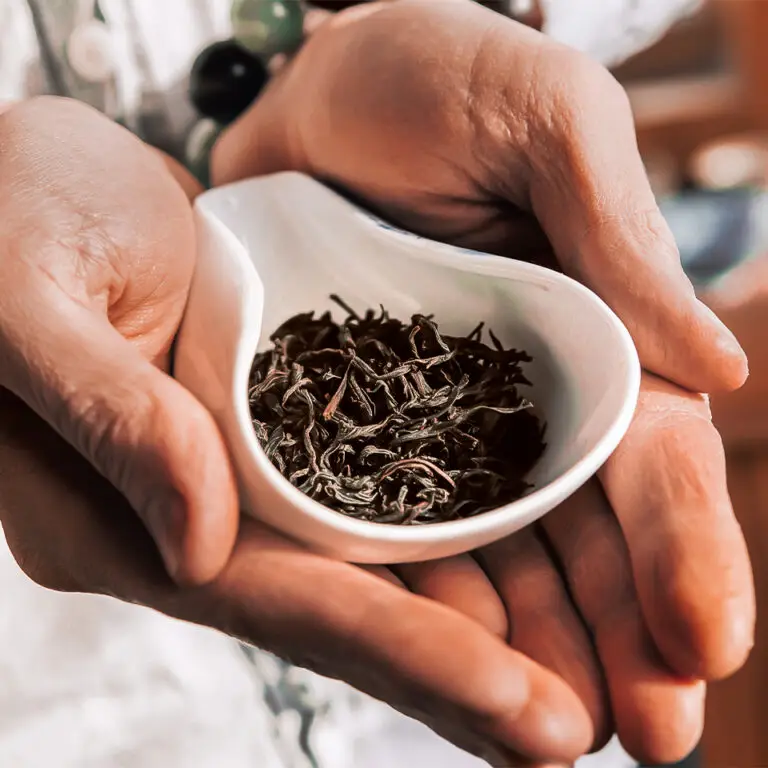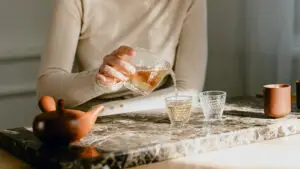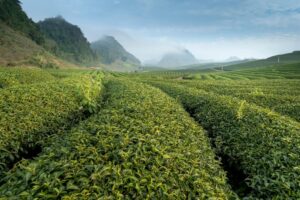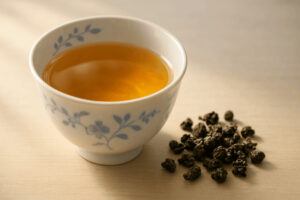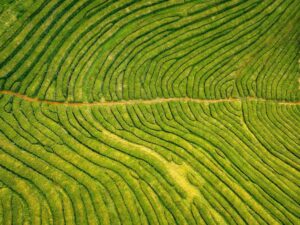Between green and black tea lies a remarkable variety – oolong tea. Known for its distinct character and rich heritage, this partially oxidized tea offers a depth of flavor that has made it a favorite among tea lovers worldwide.
A life with tea indeed seems wonderful. Those who love oolong tea must be captivated by its high fragrance and unique, enduring charm.
Definition of Oolong Tea
In some Chinese dialects, “oolong” means “confused.” That’s why in soccer, an own goal is also called an “oolong goal.” So why is such a delightful tea called “confused tea”?
According to legend, a tea farmer once gathered fresh tea leaves on a mountain and carried them down in a bamboo basket. The rough mountain path caused the basket to shake and jostle, which unexpectedly bruised the leaves and released a floral fragrance. The farmer used this accidental discovery to develop a special tea processing technique called “shaking green.” Back then, lacking scientific explanations, the mysterious aroma was attributed to this “confused” process, hence the name “oolong tea.”
The person who first coined the term “oolong tea” probably never imagined the confusion it would cause. For example, oolong tea might be mistakenly categorized as another type of tea or thought to contain artificial fragrances due to its natural aromatic qualities.
Production and Unique Qualities of Oolong Tea
Oolong tea is crafted through several intricate steps, including fixing (kill-green), withering, shaking, partial fermentation, and roasting. This meticulous process results in high-quality tea. Oolong tea has unique brewing methods, and varying techniques can greatly affect its flavor. It is also known as “slimming tea” and “fitness tea,” making it a favorite among many.
Oolong tea, also known as Qing tea, was developed during the Ming and Qing dynasties. Anxi tea farmers expanded on green tea processing methods to create oolong tea, which then spread to northern Fujian, Guangdong, and later Taiwan.
Oolong tea is a semi-fermented tea, standing out among the major types of Chinese tea for its distinctive characteristics. The combination of green tea’s freshness and black tea’s richness gives oolong tea its unique flavor profile, making it highly versatile and appreciated worldwide.
Oolong tea is beloved for its complex flavors, which can range from floral and fruity to woody and roasted. Its reputed health benefits, including aiding in weight loss and promoting overall wellness, contribute to its popularity.
With the right brewing techniques and an appreciation for its rich history and flavors, oolong tea can be a delightful and rewarding part of your daily routine.
The Vast Family of Oolong Tea
Oolong tea is a unique category of tea native to China, primarily produced in the northern and southern regions of Fujian province, as well as in Guangdong, Taiwan, and more recently, in smaller quantities in Hunan province.
ONE. By Region:
- Southern Fujian (Minnan) Oolong Tea
- Characteristics: Known for its intense fragrance, lasting aroma through multiple infusions, and a sweet aftertaste that lingers in the throat.
- Notable Teas:Tieguanyin (Iron Goddess)
- * Premier variety known worldwide
- * Tightly rolled emerald leaves with a frost-like coating
- * Distinctive orchid aroma and sweet aftertaste
- * Multiple infusions reveal evolving flavors
- – Other Notable Varieties
- * Huangjingui (Golden Cassia)
- * Benshan (Original Mountain)
- * Maoxi (Hairy Crab)
- Northern Fujian (Minbei) Oolong Tea
- Characteristics: Renowned for its strong aroma, rich and mellow taste, and unique “rock rhyme” (yan yun).
- Notable Teas: Wuyi Rock Tea (Da Hong Pao)
- * Grown in the UNESCO-protected Wuyi Mountains
- * Famous for its “rock essence” mineral taste
- * Premier variety: Da Hong Pao (Big Red Robe)
- * Dark, twisted leaves with reddish edges
- * Rich, complex flavor with lasting sweetness
- Other Varieties: Wuyi Rougui, Wuyi Shuixian, and various single bush (Dan Cong) varieties collectively referred to as Wuyi Qi Zhong or Wuyi Vegetable Tea.
- Guangdong Oolong Tea
- Characteristics: Known for a wide range of fragrances, particularly the top ten aroma types.
- Notable Teas: Phoenix Mountain (Fenghuang)-Dan Cong
- * Single-bush teas with distinct aromatic profiles
- * Known for mimicking various natural fragrances
- * Long, dark leaves with elegant twists
- * Famous varieties include:
- Mi Lan Xiang (Honey Orchid)
- Yu Lan Xiang (Magnolia)
- Xing Ren Xiang (Almond)
- Taiwan Oolong Tea
- Characteristics: Introduced from Fujian during the Qing dynasty, Taiwan Oolong tea has developed its own distinctive varieties.
- Notable Teas: High Mountain Teas
- – Dong Ding (Frozen Summit)
- * Traditional charcoal-roasted style
- * Rich, smooth body with caramel notes
- – Alishan
- * Grown at high elevations (1000-2000m)
- * Naturally sweet with floral notes
- – Other Distinctive Varieties
- * Jin Xuan (Milk Oolong)
- * Baozhong (Wrapped Sort)
- * Oriental Beauty (Dongfang Meiren)
- – Dong Ding (Frozen Summit)
- Other Varieties: Jin Xuan, Cui Yu, Muzha Tieguanyin, and various high mountain Oolong teas.
Oolong tea, also referred to as Qing tea, is a semi-fermented tea that occupies a distinctive place among Chinese teas. Developed during the Ming and Qing dynasties by Anxi tea farmers, it combines the freshness of green tea and the richness of black tea, resulting in a diverse range of flavors and aromas.
TWO. Classification by Shape
The shape of oolong tea leaves reveals much about their processing method and origin. There are four main shape classifications, each reflecting distinct crafting traditions and brewing characteristics.
- Strip-shaped Oolong Tea
These teas feature long, twisted leaves that unfurl beautifully during brewing. The most renowned examples include:- Wuyi Rock Tea (Yancha): Known for its dark, robust twisted strips
- Phoenix Dan Cong: Distinguished by its long, elegant leaves
- Wenshan Baozhong: A Taiwanese variety featuring gently twisted, lighter oxidized leaves
The strip style allows these teas to release their complex flavors gradually, making them ideal for multiple infusions. When brewed, the leaves should fully unfurl, displaying the craftmanship of their processing.
- Ball-Rolled Oolong Tea
Characterized by their tightly rolled, pearl-like appearance, these teas represent another traditional processing style. Notable varieties include:- Tieguanyin: Compact, dark green pearls
- Dong Ding: Taiwan’s famous high-mountain oolong, tightly rolled into small balls
- Ali Shan and Li Shan: Premium Taiwanese high-mountain oolongs, known for their perfectly formed pearls
This shape helps preserve the tea’s aromatic qualities and ensures consistent infusion. Taiwan has particularly mastered this rolling technique, with most of its high-mountain oolongs adopting this style for optimal flavor preservation.
- Bundled Oolong Tea
Less common but traditionally significant, bundled oolongs are carefully tied into distinctive shapes. The primary example is:- Bajiaoting Longxu Tea: Crafted to resemble dragon whiskers, these bundles create a unique visual presentation
- Compressed Oolong Tea
The rarest shape category, compressed oolongs are primarily represented by:- Zhangping Shuixian: Pressed into small cakes, this unique style combines traditional processing with innovative shaping techniques
THREE. Classification by Fermentation Level
Oolong teas occupy a unique position between green and black teas, with oxidation levels ranging from 10% to 70%. This variation creates distinct flavor profiles and appearances, offering tea enthusiasts a broad spectrum of tasting experiences.
- Light Oxidation (10-25%)
These oolongs retain many characteristics of green tea while developing their own unique qualities:- – Baozhong Tea
* Pale, bright liquor
* Fresh, floral aroma
* Gentle, sweet finish - – Modern Tieguanyin
* Emerald green leaves
* Orchid-like fragrance
* Clean, refreshing taste
- – Baozhong Tea
- Medium Oxidation (25-50%)
The “sweet spot” of traditional oolong processing, these teas offer complex flavor profiles:- Classic Phoenix Dan Cong
* Golden-amber liquor
* Distinctive honey-orchid notes
* Rich, lingering aftertaste - Traditional Dong Ding
* Deep golden color
* Balanced floral and fruit notes
* Smooth, full body - Wuyi Rock Tea
* Amber infusion
* Mineral undertones
* Rich, warming character
- Classic Phoenix Dan Cong
- Heavy Oxidation (50-70%)
These oolongs approach black tea characteristics while maintaining oolong distinctiveness:- Oriental Beauty
* Deep amber color
* Honey-like sweetness
* Fruit and wood notes - Aged Phoenix Dan Cong
* Dark amber liquor
* Deep, complex flavor
* Pronounced honey sweetness
- Oriental Beauty
Each oxidation level brings out different aspects of the tea leaves, influenced by factors such as terroir, processing skill, and seasonal variations. Traditional craftsmen often adjust oxidation levels based on the specific characteristics of each harvest, aiming to bring out the tea’s optimal qualities.
Understanding Oolong Tea: A Conclusion
Oolong tea represents one of the most diverse and sophisticated categories in the tea world. From its legendary origins as an accidental discovery to its current status as a globally appreciated beverage, oolong tea embodies centuries of craftsmanship and innovation.
What makes oolong truly special is how these elements combine to create teas that are both traditional and adaptable, capable of satisfying both casual tea drinkers and serious connoisseurs. Whether enjoying the honey-orchid notes of Phoenix Dan Cong, the mineral complexity of Wuyi Rock tea, or the fresh florals of high mountain Taiwan oolongs, each cup offers a unique experience that reflects its origin, crafting method, and oxidation level.
As we continue to appreciate this remarkable tea category, we understand that oolong is more than just a beverage – it’s a living tradition that connects us to centuries of tea culture while remaining relevant in our modern world. Its diversity ensures that there’s an oolong tea for every palate, making it a truly universal tea category that rewards continued exploration and appreciation.
